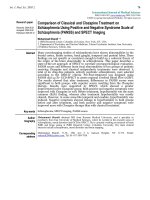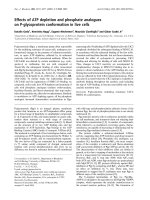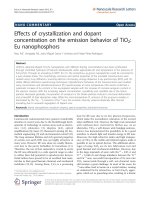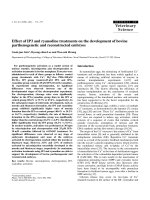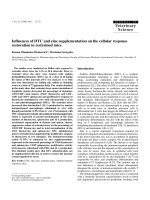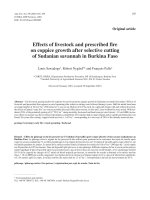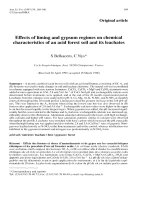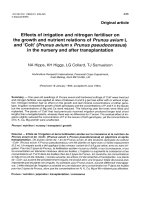Báo cáo y học: "Effects of etizolam and ethyl loflazepate on the P300 event-related potential in healthy subjects" docx
Bạn đang xem bản rút gọn của tài liệu. Xem và tải ngay bản đầy đủ của tài liệu tại đây (836.55 KB, 7 trang )
PRIMARY RESEARCH Open Access
Effects of etizolam and ethyl loflazepate on the
P300 event-related potential in healthy subjects
Goro Fukami
1*
, Tasuku Hashimoto
1
, Yukihiko Shirayama
1
, Tadashi Hasegawa
1
, Hiroyuki Watanabe
1
, Mihisa Fujisaki
1
,
Kenji Hashimoto
2
, Masaomi Iyo
1
Abstract
Background: Benzodiazepines carry the risk of inducing cognitive impairments, which may go unnoticed while
profoundly disturbing social activity. Furthermore, these impairments are partly associated with the elimination half-
life (EH) of the substance from the body. The object of the present study was to examine the effects of etizolam
and ethyl loflazepate, with EHs of 6 h and 122 h, respectively, on information processing in healthy subjects.
Methods: Healthy people were administered etizolam and ethyl loflazepate acutely and subchronically (14 days).
The auditory P300 event-related potential and the neuropsychological batteries described below were employed to
assess the effects of drugs on cognition. The P300 event-related potential was recorded before and after drug
treatments. The digit symbol test, trail making test, digit span test and verbal paired associates test were
administered to examine mental slowing and memory functioning.
Results: Acute administ ration of drugs caused prolongation in P300 latency and reduction in P300 amplitude.
Etizolam caused a statistically significant prolongation in P300 latency compared to ethyl loflazepate. Furthermore,
subchronic administration of etizolam, but not ethyl loflazepate, still caused a weak prolongation in P300 latency.
In contrast, neuropsychological tests showed no difference.
Conclusions: The results indicate that acute administration of ethyl loflazepate induces less effect on P300 latency
than etizolam.
Background
Benzodiazepines have anxiolytic , sedative, anticonvulsant
and myorelaxant properties, and have been widely pre-
scribed in various clinical settings. These compounds,
however, also induce adverse effects such as overseda-
tion, cognitive impairment, motor impairment and with-
drawal. These adverse effects may be partly associated
with the elimination half-life (EH) of the compounds
from the body; that is, long-term use of the compounds
with a short elimination rate may induce withdrawal
syndromes, whereas accumulation-related effects of a
long elimination rate may include oversedation, cogni-
tive dysfunction and motor impairment [1-4].
It has been observed previously that cognitive impair-
ment induced by benzodiazepines may go unnoticed
while profoundly disturbing social activity [5]. Therefore,
it is clinically very important to take note of the cognitive
effects of benzodiazepines. In order to assess the effects
of benzodiazepines on cognition, the event-related poten-
tial (ERP), P300, may be useful [6], as well as neuropsy-
chological tests. The P300 components of ERP are
elicited by an auditory oddball paradigm in which a sub-
ject detects infrequent task-relevant stimuli randomly
presented among frequent stimuli. P300 reflects stimulus
context and stimulus meaning [7]. P300 components are
associated with cognitive processes such as attention,
memory, orientation and evaluation. Relationships
between P300 and neuropsychological function have
been reported [8-14]. Benzodiazepine anxiolytic drugs, as
well as benzodiazepine hypnotic drugs, have been
reported to induce reductions in P300 amplitude and
prolongation in P300 latency [6,15-20].
As far as is known, however, there are no reports on
the effects of chronic or subchronic administration of
benzodiazepines on cognition and P300 from the view-
point of elimination rates. Here, we studied the effects
* Correspondence:
1
Department of Psychiatry, Chiba University Graduate School of Medicine,
Chiba, Japan
Full list of author information is available at the end of the article
Fukami et al. Annals of General Psychiatry 2010, 9:37
/>© 2010 Fukami et al; licensee BioMed Central Ltd. This is an Open Access article distributed under the terms of the Creative Commons
Attribution License ( which permits unrestricted use, distribution, and reproduction in
any medium, provided the original work is properly cited.
of anxiolytic benzodiazepines on neuropsychological
functions and P300 components of aud itory ERP under
acut e and subchronic administration of ethyl loflazepate
and etizolam. Ethyl loflazepate is a potent, non-sedative,
anxiolytic drug with a long EH of 122 h [21], whereas
etizolam is characteristic of a potent antianxiety and
sedative drug with a short EH of 6 h [22]. Therefore,
etizolam is often used as a sleep inducer. However, it is
well known that benzodiazepine drugs including etizo-
lam and ethyl loflazepate have the effects of reducing
the deep sleep stage 3, resulting in loss of good sleep.
Theaimofthepresentstudyistoexaminewhether
sedative or anxiolytic actions of benzodiazepines have
some effects on ERP and neuropsychological tests.
Methods
Study design and subjects
All subjects had normal acoustic function and were
right handed. The ethics committee of Chiba University
Graduate School of Medicine approved the experiments.
Subjects were free from treatment for past psychiatric
illness. Written informed consent was obtained after the
procedure had been fully explained.
In the acute experiment, 10 healthy men (n = 5) and
women (n = 5) ranging in age from 16 to 38 (average age
28.6 (SD 6.5)) participated in the study. First, all subjects
were measured for the P300 components of ERP and
received neuropsychological tests. Then they took etizo-
lam(1or2mg,orally).Then,2hlater,thesameERP
and neuropsychological tests were performed, since the
blood concentration of the drugs reaches a maximum 1-2
h after consumption. After a 2-week washout period, the
same experimental procedures were repeated, but sub-
jects took ethyl loflazepate (1 or 2 mg, orally).
In the subchronic experiment, 17 healthy men (n = 8)
and women (n = 9) ranging in age from 22 to 34 (aver-
age age 27.4 (SD 4.1)) participated in the study. The 17
subjects were divided into 2 gro ups: the first group was
given etizolam (1 mg, orally, for 14 days), and the sec-
ond given ethyl loflazepate (1 mg, orally for 14 days).
Subjects were asked to take drugs in the evening every
day, and performed ERP recording and neuropsychologi-
cal tests 14-20 h after taking the last drug. Subjects per-
formed ERP recording and neuropsychological tests
twice before and after subchronic treatment with etizo-
lam or ethyl loflazepate.
Doses examined in the present study were chosen
based on the equivalent conversion table for anxiolytic
drugs(5mgofdiazepam,1.5mgofetizolam,and1.67
mg of ethyl loflazepate) [23,24].
ERP procedure
Electroencephalogram electrodes were attached at Fz, Cz
and Pz according to the international 10-20 system.
Earlobe electrodes were linked for reference. Electro-
oculography was also recorded from vertical and lateral
derivations to check ocular artefacts. Subjects sat on a
semi-reclined chair in a sound-attenuated and electri-
cally shielded room during recordings. Subjects were
instructed to press a button as quickly as possible upon
hearing the infrequent high-pitched tones. Event-related
potentials were recorded under an oddball paradigm.
The stimuli consisted of a 1,000 Hz tone burst (frequent
non-target stimulus) and a 2,000 Hz tone burst (rare
target stimulus). In each paradigm, 200 stimuli were
presented through bilateral earphones by using a Neuro-
pack 10 (MEB-2200, Nihon Kohden, Tokyo, Japan). The
ratio of the rare versus freque nt stimuli was 0.25. Sti-
muli were presented in a random order, the durati on of
each stimulus being 120 ms, with rise and fall times of
10 ms. The intensity w as 40 dB for all stimuli. The
interstimulus interval was 1.5 s.
Neuropsychological tests
The trail making test consists of two parts [25]. In part
A, subjects are asked to draw lines connecting 25 conse-
cutively numbered circles on a worksheet. In part B,
they draw lines connecting 25 consecutively numbered
and lettered circles, alternating between the sequence s
(for example, 1-A-2-B-3 and so on). Part A examines
psychomotor speed and attention. Part B examines set
alternation or divided attention.
The digit symbol modalities test is a measure of
switching attention [26]. Subjects are asked to identify
nine different symbols corresponding to the numbers 1
through 9, and write the correct number under the cor-
responding symbol. Thus, visual shifting and pairing of
specific digits is directed, with a set of prespecified
symbols.
The forward digit span test is a measure of simple
attention, immediate memory and attentional control
processing. In contrast, backward digit span is not only
a test of attentional control processing but also working
memory test.
The verbal paired associates test from the Wechsler
Memory Scale-Revised (WMS-R) is a cued recall test of
verbal memory [27]. Subjects learned a l ist of eight ver-
bal paired associates. Then, either immediately or after a
delay, the examine r says one word of each pair and the
subjects recall the other word. Three sets of immediate
memory testing and one set of delayed recall testing
were administered.
Statistical analysis
Two-way repeated measures analysis of variance
(ANOVA) was performed to assess the overall differences
between variables. Where a significant interaction in the
within-subject variables was found, subsequent one-way
Fukami et al. Annals of General Psychiatry 2010, 9:37
/>Page 2 of 7
ANOVA was carried out among more than three groups
by a post hoc comparison using Fisher’s protected least
significant difference test. For comparison of the mean
values bet ween the two groups, statistical evaluation was
performed using the two-tailed Student’sttest.Thesig-
nificance level was set at P < 0.05.
Results
Effects of acute treatments with etizolam and ethyl
loflazepate on P300
For acute drug treatment on the P300, two-way repeated
ANOVA indicated significant effects of treatment (Fz, F
(1,16) = 49.397, P < 0.0001; Cz, F (1,16) = 59.022, P <
0.0001; Pz, F (1,16) = 45.623, P < 0.0001), but not effects
of group, on latency, with a significant interaction (Fz,
treatment × group, F (3,16) = 3.846, P = 0.0301; Cz,
treatment × group, F (3,16) = 3.436, P = 0.0423; Pz,
treat ment × group, F (3,16) = 3.278, P = 0.0483) (Figure
1a-c). The subsequent one-way ANOVA on the changes
of P300 latency indicated significant differences (Fz, F
(3,16) = 3.431, P = 0.0425; Cz, F (3,16) = 3.436, P =
0.0423; Pz, F (3,16) = 3.387, P = 0.0441), and the post
hoc comparison using Fisher’s protected least significant
difference test indicated the following: ethyl loflazepate
1 mg has less effects than etizolam 1 mg and etizolam 2
mg in Fz (Figure 1g), Cz (Figure 1h), and Pz (Figure 1i).
For amplitude, two-way repeated ANOVA indicated sig-
nificant effects of treatment (Cz, F ( 1,16) = 7.967, P =
0.0123; Pz, F (1,16) = 8.807, P = 0.0091; but see Fz, F
(1,16) = 4.032, P = 0.0618), but not effects of group,
without a significant interaction (Figure 1d-f). This
seems to refle ct that benzodiazepine reduced P300
amplitude. Although the subsequent one-way ANOVA
on the changes of P300 amplitude revealed no signifi-
cant difference among drug groups (Figure 1j-l), the
magnitude of changes showed that etizolam (2 mg) pro-
duced a trend in reduction of amplitude.
Effects of subchronic treatments with etizolam and ethyl
loflazepate on P300
For subchronic drug treatment on the P300, two-way
repeated ANOVA indicated significant effects of treat-
ment region specifically (Fz, F (1,15) = 7.734, P = 0.0140;
but see Cz, F (1,15) = 2.391, P = 0.1491; Pz, F (1,15) =
Figure 1 Effects of acute treatments with etizolam and ethyl loflazepate on P300.*P < 0.05, **P < 0.01, ***P <0.001comparedto
pretreatment (repeated analysis of variance (ANOVA)). (a) Trend for changes without significance. *P < 0.05, **P < 0.01 compared to ethyl
loflazepate with low dose (1 mg) (ANOVA followed by Fisher’s protected least significant difference test).
Fukami et al. Annals of General Psychiatry 2010, 9:37
/>Page 3 of 7
0.954, P = 0.3443), but not effects of group, on latency,
without a significant interaction (Figure 2a-c). The subse-
quent Student t test on the changes of P300 latency
revealed no significant difference b etween two drugs
(Figure 2g-i). With regard to amplitude, two-way
repeated ANOVA indicated no significant effects of treat-
ment without a significant interaction (Figure 2d-f, j-l).
Effects of treatments with etizolam and ethyl loflazepate
on neuropsychological tests
For acute effects of drug treatment on neurops ychol ogi-
cal tests, two-way repeated ANOVA showed significant
practice effects of repeated testing, but not effects of
drug group, on test scoring without a significant interac-
tion in some tests including trail making A (F (1,16) =
7.399, P = 0.0151, Figure 3a), trail making B (F (1,16) =
8.409, P = 0.0104, Figure 3b), digit span forward (F
(1,16) = 8.696, P = 0.0094, Figure 3c), verbal paired
associates immediate memory (F(1,16) = 6.485, P =
0.0215, Figure 3e) and digit symbol (F(1,16) = 24.209, P
= 0.0002, Figure 3g), and no significant effects of
repeated testing and drugs on test scoring without a sig-
nificant interaction in other tests such as d igit span
backward (Figure 3d) and verbal paired associates
delayed recall (Figure 3f).
For subchronic effects of drug treatment on neuropsy-
chological tests, two-way repeated ANOVA indicated
significant practice effects of repeated testing, but not
effects of drug group, on test scoring without a signifi-
cant interaction, in some tests including trail making
test A (F (1,15) = 1 2.472, P = 0.0030, Figure 3h), trail
making test B (F (1,15) = 5.426, P = 0.0342, Figure 3i),
digit span forward (F (1,15) = 7.092, P = 0.0177, Figure
3j), verbal paired associates immediate memory (F (1,15)
= 16.449, P = 0.0010, Figure 3l), verbal paired associates
delayed recall ( F (1,15) = 5.773, P = 0.0297, Figure 3m)
and digit symbol (F (1,15) = 6.075, P = 0.0236, Figure
3n), and no significant effects of repeated testing and
drug group on test scoring without a significant interac-
tion in digit span backward test (Figure 3k).
Discussion
Our results show acute drug treatment induced prolon-
gation in P300 latency. This is consistent with previous
studies demonstrating that benzodiazepines such a s
alprazolam, lorazepam, clonazepam and triazolam
induce prolongation in P300 la tency [6,16,18,19]. How-
ever, subsequent ANOVA revealed that etizolam (1 and
2 mg) induced significant prolongation in P300 latency
compared to ethyl loflazepate (1 mg). The difference
Figure 2 Effect s of subchronic treatments with etizolam and ethyl loflazepate on P300.*P < 0.05 compared to pretreatment (repeated
analysis of variance (ANOVA)).
Fukami et al. Annals of General Psychiatry 2010, 9:37
/>Page 4 of 7
between the ac ute effects of etizolam and ethyl loflaze-
pate could contribute to the potent sedative effects of
etizolam, although equivalent doses of these two drugs
to diazepam are clinically almost the same. P300 latency
is suggested to reflect the stimulus evaluation time, and
is relatively independent of response selection and
execution [28-30]. Therefore, it is conceivable that ethyl
loflazepate has less effect on P300-related information
processing, although the subjects did not exhibit any
harmful effects on motor skills, visuomotor tracking
speed, and delayed memory in the neuropsychological
tests.
Secondly, subchronic treatment with drugs produced
prolongation in P300 latency only in th e Fz regions.
Weak prolongation in P300 latency was seen in the eti-
zolam-treated subjects (although this was not statisti-
cally significant). The magnitude of prolongation by
subchronic ethizolam treatment was reduced when com-
pared to the acute administration of etizolam. In sup-
port of this finding, previous studies reported that
people develop tolerance to the sedative and cognitive
effects of benzodiazepines after subchronic treatments
[1]. Interestingly, subchronic treatment of ethyl loflaze-
pate did not prolong the latency in spite of its long
elimination rate.
Finally, acute but not subchronic treatment with ben-
zodiazepine reduced P300 amplitude. Based on the mag-
nitude of changes, the main effects on the reduction of
P300 amplitude were produced by etizolam (2 mg). This
result replicated previous studies that benzodiazepine
anxiolytic drugs (lorazepam, clonazepam and alprazo-
lam) induced reductions in P300 amplitude [15,17].
Recent studies demonstrated that reduction in auditory
P300 amplitude correlated with the severity of thought
disorders [31,32]. Previous studies reported that a single
administration of a benzodiazepine drug produced
impairment of learning and memory [1-3]. However, the
present study showed no aversive effects of the exam-
ined drugs on neuropsychological tasks such as atten-
tion-needed tasks (trails making test, digit span) and
memory (verbal paired associates, digit symbol). Since
thesubjectswerefreefromabnormalpathological
Figure 3 Effects of acute and subchronic treatment with etizolam and ethyl loflazepate on neuropsychological tests.
Fukami et al. Annals of General Psychiatry 2010, 9:37
/>Page 5 of 7
process, alterations in the P300 may be induced by eti-
zolam, not by symptom alleviation due to etizolam.
Differences in the effects on P300 latency between eti-
zolam and ethyl loflazepate could be attributed to their
pharmacological properties, such as sedative effects, and
affinities for ω-1 and ω-2 sites. Etizolam is short acting
(EH of 6 h) whereas ethyl loflazepate is long acting (EH
of 122 h).
With regard to limitations of the present study, the
sample size was small.
Conclusions
Acute administration of etizolam induced significant
prolongation in P300 latency whereas low dose ethyl
loflazepate induced fewer effects on P300 latency in the
Fz, Cz and Pz regions than low-dose etizolam. For a
while, subchronic administration of etizolam, but not
ethyl loflazepate, caused weak prolongation in P300
latency in the Fz but not Cz and Pz regions. In contrast,
acute and chronic admi nistratio ns of etizol am and ethyl
loflazepate showed no deficits in motor skills, visuomo-
tor tracking speed, and delayed memory on neuropsy-
chological testing.
Author details
1
Department of Psychiatry, Chiba University Graduate School of Medicine,
Chiba, Japan.
2
Division of Clinical Neuroscience, Chiba University Center for
Forensic Mental Health, Chiba, Japan.
Authors’ contributions
GF conceived the paper, designed the study, performed the psychological
measures, collected data, carried out the statistical analysis and drafted the
paper; THash performed the psychological measures; YS carried out the
statistical analysis and helped draft the study; THase, HW and MF supervised
the study; KH and MI designed the study and helped draft the papers. All
authors read and approved the final manuscript.
Competing interests
The authors declare that they have no competing interests.
Received: 13 June 2010 Accepted: 3 November 2010
Published: 3 November 2010
References
1. Files SE, Lister RG: Lorazepam-induced deficits in learning result from
impaired rehearsal, reduced motivation, or increased sedation? Br J Clin
Pharmacol 1982, 14:545-550.
2. Block RI, Berchou R: Alprazolam and lorazepam effects on memory
acquisition and retrieval processes. Pharmac Biochem Behav 1984,
20:233-241.
3. Curran HV: Tranquilizing memories: a review of the effects of
benzodiazepines on human memory. Biol Psychology 1986, 23:179-213.
4. Chouinard GJ: Issues in the clinical use of benzodiazepines: potency,
withdrawal, and rebound. J Clin Psychiatry 2004, 65(Suppl 5):7-12.
5. Stewart SA: The effects of benzodiazepines on cognition. J Clin Psychiatry
2005, 66(Suppl 2):9-13.
6. Urata J, Uchiyama M, Iyo M, Enomoto T, Hayakawa T, Tomiyama M,
Nkajima T, Sasaki H, Shirakawa S, Wada K, Fukui S, Yamadera H, Okawa M:
Effects of a small dose of triazolam on P300 and resting EEG.
Psychopharmacology 1996, 125:179-184.
7. Polich J, Kok A: Cognitive and biological determinants of P300: an
integrative review. Biol Psychology 1995, 41:103-146.
8. Emmerson RY, Dustman RE, Shearer DE, Turner CW: P3 latency and symbol
digit performance correlations in aging. Exp Aging Res 1989, 15:151-159.
9. O’Donell BF, Friedman S, Swearer JM, Drachman DA: Active and passive P3
latency and psychometric performance: influence of age and individual
differences. Int J Psychophysiol 1992, 12:187-195.
10. Knight RT, Scabini D: Anatomic bases of event-related potentials and
their relationship to novelty detection in humans. J Clin Neurophysiol
1998, 15:3-13.
11. Fjell AM, Walhovd KB: P300 and neuropsychological tests as measures of
aging: salp topography and cognitive changes. Brain Topogr 2001,
14:25-40.
12. McAllister-Williams RH, Massey AE, Rugg MD: Effects of tryptophan
depletion on brain potential correlates of episodic memory retrieval.
Psychopharmacology 2002, 160:434-442.
13. Walhoved KB, Fjell AM: The relationship between P3 and
neuropsychological function in an adult life span sample. Biol Psychology
2003, 62:65-87.
14. Pogarell O, Mulert C, Hegerl U: Event related potentials and fMRI in
neuropsychopharmacology. Clin EEG Neurosci 2006, 37:99-107.
15. Berchou R, Chiyasirisobhon S, Green V, Mason K: The pharmacodynamic
properties of lorazepam and methylphenidate drugs on event-related
potentials and power spectral analysis in normal subjects. Clin
Electroencephalogr 1986, 17:176-180.
16. Shinotoh H, Iyo M, Yamada T, Inoue O, Suzuki K, Itoh T, Fukuda H,
Yamasaki T, Tateno Y, Hirayama K: Detection of benzodiazepine receptor
occupancy in the human brain by positron emission tomography.
Psychopharmacology 1989, 99:202-207.
17. Rockstroh B, Elbert T, Lutzenberger W, Altenmuller E: Effects of the
anticonvulsant benzodiazepine clonazepam on event-related brain
potentials in humans. Electroencephalogr Clin Neurophysiol 1991,
78:142-149.
18. Semlitsch HV, Anderer P, Saletu B: Acute effects of the anxiolytics
suriclone and alprazolam on cognitive information processing utilizing
topographic mapping of event-related brain potentials (P300) in healthy
subjects. Eur J Clin Pharmacol 1995, 49:183-191.
19. Nichols JM, Martin F: The effect of lorazepam on memory and event-
related potentials in heavy and light social drinkers. Psychophysiology
1996, 33:446-456.
20. Hayakawa T, Uchikawa M, Urata J, Enomoto T, Okubo J, Okawa M: Effects
of small dose of triazolam on P300. Psychiatry Clin Neurosci 1999,
53:185-187.
21. Chambon JP, Perio A, Demarne H, Hallot A, Dantzer R, Roncucci R, Biziere K:
Ethyl loflazepate: a prodrug from the benzodiazepine series designed to
dissociate anxiolytic and sedative activities. Arzneimittelforschung 1985,
35:1573-1577.
22. Tsumagari T, Nakajima A, Fukuda T, Shuto S, Kenjo T, Morimoto Y,
Takigawa Y: Pharmacological properties of 6-(o-chlorophenyl)-8-ethyl-1-
methyl-4H-s-triazolo[3,4-c]thieno[2,3-e] [1,4]diazepine (Y-7131), a new
anti-anxiety drug. Arzneimittelforschung 1978, 28:1158-64.
23. Inagaki A, Inada T, Fujii Y, Yagi K, Yoshio T, Nakamura H, Yamauchi T: Dose
equivalence of psychotropic drugs [in Japanese] Tokyo, Japan: Seiwa Shoten
Co. Ltd; 1999, 99-121.
24. Inada T, Nozaki S, Inagaki A, Furukawa TA: Efficacy of diazepam as an anti-
anxiety agent: meta-analysis of double-blind, randomized controlled
trials carried out in Japan. Human Psychopharmac Clin Exp 2003,
18:483-487.
25. Reitan RM, Wolfson D: The Halstead-Reitan Neuropsychological Test Battery
Tucson, AZ, USA: Neuropsychology Press; 1985.
26. Smith A: Symbol Digit Modalities Test (SDMT): Manual (revised) Los Angeles,
CA, USA: Western Psychological Services; 1982.
27. Wechsler DA: Wechsler Memory Scale-Revised, Manual New York, USA:
Psychological Corp; 1987.
28. Kutas M, McCarthy G, Donchin E: Augmenting mental chronometry: the
P300 as a measure of stimulus evaluation time. Science 1977,
197:792-795.
29. McCarthy G, Donchin E: A metric for thought: a comparison of P300
latency and reaction time. Science 1981, 211:77-80.
30. Magliero A, Bashoe TR, Coles MG, Donchin E: On the dependence of P300
latency on stimulus evaluation processes. Psychophysiology 1984,
21:171-186.
Fukami et al. Annals of General Psychiatry 2010, 9:37
/>Page 6 of 7
31. Higashima M, Nagasawa T, Kawasaki Y, Oka T, Sakai N, Tsukada T, Koshino Y:
Auditory P300 amplitude as a state marker for positive symptoms in
schizophrenia: cross-sectional and retrospective longitudinal studies.
Schizophr Res 2001, 59:147-157.
32. Iwanami A, Okajima Y, Isono H, Shinoda J, Kasai K, Hata A, Fukuda M,
Nakagome K, Kamijima K: Effects of risperidone on event-related
potential in schizophrenic patients. Pharmacopsychiatry 2001, 34:73-79.
doi:10.1186/1744-859X-9-37
Cite this article as: Fukami et al.: Effects of etizolam and ethyl
loflazepate on the P300 event-related potential in healthy subjects.
Annals of General Psychiatry 2010 9:37.
Submit your next manuscript to BioMed Central
and take full advantage of:
• Convenient online submission
• Thorough peer review
• No space constraints or color figure charges
• Immediate publication on acceptance
• Inclusion in PubMed, CAS, Scopus and Google Scholar
• Research which is freely available for redistribution
Submit your manuscript at
www.biomedcentral.com/submit
Fukami et al. Annals of General Psychiatry 2010, 9:37
/>Page 7 of 7
